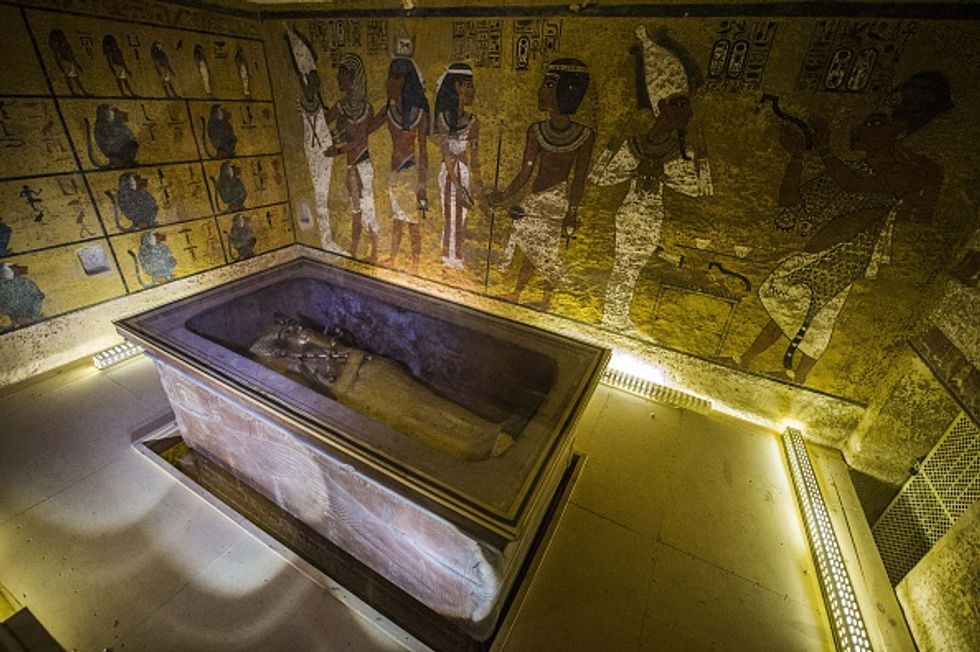CAIRO (TheBlaze/AP) — Egypt on Saturday said there is a 90 percent chance that hidden chambers will be found within King Tutankhamun's tomb, based on the preliminary results of a new exploration of the 3,300-year-old mausoleum.
Speaking at a press conference in Luxor on Saturday, Antiquities Minister Mamdouh el-Damaty said the results will be sent to Japan for a monthlong analysis before the search is resumed.
 Egypt's Minister of Antiquities Mamduh al-Damati (L) and British Egyptologist Nicholas Reeves (R) attend a joint press conference in Luxor, 500 kms south of Cairo on November 28, 2015. Scans in King Tutankhamun's tomb in Egypt's Valley of the Kings point to a hidden chamber, the country's antiquities minister said Saturday, possibly heralding the discovery of Queen Nefertiti's resting place. (KHALED DESOUKI/AFP/Getty Images)
Egypt's Minister of Antiquities Mamduh al-Damati (L) and British Egyptologist Nicholas Reeves (R) attend a joint press conference in Luxor, 500 kms south of Cairo on November 28, 2015. Scans in King Tutankhamun's tomb in Egypt's Valley of the Kings point to a hidden chamber, the country's antiquities minister said Saturday, possibly heralding the discovery of Queen Nefertiti's resting place. (KHALED DESOUKI/AFP/Getty Images)
"We said earlier there was a 60 percent chance there is something behind the walls. But now after the initial reading of the scans, we are saying now it's 90 percent likely there is something behind the walls," Damaty said.
British Egyptologist Nicholas Reeves theorizes that Tutankhamun, better known as King Tut, who died at the age of 19, may have been rushed into an outer chamber of what was originally Queen Nefertiti's tomb. Reeves had speculated in October that Tutankhamum's mausoleum had been originally occupied by Nefertiti.
"There is, in fact, an empty space behind the wall based on radar, which is very accurate, there is no doubt. We cannot say at this point however the size of the space behind the wall," Japanese radar specialist Hirokatsu Watanabe said at Saturday's news conference, according to Reuters.
 Japanese expert Hiroaki Watanabe speaks during a joint press conference with Egypt's Minister of Antiquities Mamduh al-Damati and British Egyptologist Nicholas Reeves in Luxor (KHALED DESOUKI/AFP/Getty Images)
Japanese expert Hiroaki Watanabe speaks during a joint press conference with Egypt's Minister of Antiquities Mamduh al-Damati and British Egyptologist Nicholas Reeves in Luxor (KHALED DESOUKI/AFP/Getty Images)
"We have the data but we must analyse it to understand," Watanabe continued. "But we are working in the Valley of the Kings, so we are expecting to find antiquities behind the wall.
It's been a question of interest for experts as to why Tutankhamum's tomb is smaller in size that that of other pharaohs. It's shape is also more aligned to that of the tombs of the Egyptian queens during that era.
 A picture taken on November 28, 2015 shows the sarcophagus of King Tutankhamun displayed in his burial chamber in the Valley of the Kings, close to Luxor, 500 kms south of the Egyptian capital, Cairo. (KHALED DESOUKI/AFP/Getty Images)
A picture taken on November 28, 2015 shows the sarcophagus of King Tutankhamun displayed in his burial chamber in the Valley of the Kings, close to Luxor, 500 kms south of the Egyptian capital, Cairo. (KHALED DESOUKI/AFP/Getty Images)
Famed for her beauty, Nefertiti was the subject of a famous 3,300-year-old bust and is thought to be the stepmother of Tutankhamum.
Luxor, in southern Egypt, served as the pharaonic capital in ancient times, and is home to sprawling temples and several ancient tombs.






